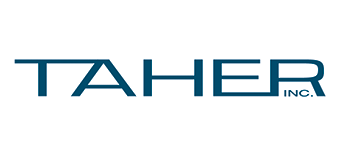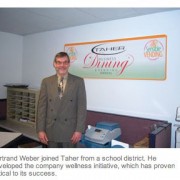With one of the largest and most respected commissaries in the state of Minnesota, Bruce Taher reasoned the company was in a great position to win some of the bigger vending contracts.
Taher Food Service had long established a reputation for excellence with its USDA certified commissary and provided foodservice to schools in several states, along with senior dining centers and a handful of restaurants.
2006: WELLNESS BECOMES A FOCUS
In 2006, Shawn Taher called on the Hopkins, Minn. school district, which was handling its vending in-house. The district’s foodservice director had decided he could provide more nutritious vend offerings than what the vending operators had to offer.
The foodservice director gave Shawn Taher a chance to sell his company’s vending program, but Taher quickly realized that he wasn’t prepared to offer the type of program that the district was providing. When he told his father about the meeting, the elder Taher realized that a market existed for wellness that few if any vending operators were meeting.
Bruce Taher decided that the foodservice director his son had met with was someone who could bring nutrition expertise to Taher Food Service. So he hired him.
NUTRITION EXPERT JOINS THE TAHER TEAM
“I had a real passion for changing how we feed kids,” said Bertrand Weber, the former school Hopkins, Minn. foodservice director who now serves as Taher Food Service’s director of wellness, nutrition and culinary  standards.
standards.
Weber brought a new level of quality to Taher Food Service’s vending operation. He had sourced vitaminwater and Naked Juice before they were available from Coca-Cola Co. He had also sourced Stacy’s Pita Chips before it was available from Pepsico Foodservice.
In 2007, Taher Food Service introduced its wellness initiative, “Food 4 Life.” The “Food 4 Life” became an overview for wellness programs in all the divisions. From this, they developed a “Sensible Choice” program for vending, school foodservice and corporate foodservice.
COMPANY SETS NUTRITION STANDARDS
The program includes logos designating certain products as Sensible Choice, healthy weight, heart healthy, essential fatty acids, high calcium, high fiber, high potassium, low carbs, low sodium, vegetarian, and locally sourced.
Sensible Choice standards are as follows: 5 percent calories from total fat or less; 40 percent calories from total fat for natural chips (no more than 10 percent of vending options); under 11 percent calories from saturated fat; no more than 35 percent sugar by weight; up to 30 grams of carbohydrates; less than 360 mg of sodium; no trans fat; and no high fructose corn syrup.
The exceptions to these guidelines are products containing naturally occurring fats, such as nuts and seeds. Fruits and vegetables are not restricted to carbohydrate standards because they provide nutrients that are beneficial to an overall balanced diet.
The company realized they had an opportunity to distinguish the vending program by offering 25 percent of the vending machine selections as healthy.
“Our goal is not to change what they eat, it’s to provide the option,” Weber said. “We have a responsibility to make a change. We have our own take about what sensible vending means.”
Before the wellness push began, it was necessary to get buy-in from the employees. Management met with all employees and explained the wellness initiative. Management explained that while the vending industry did not cause the obesity problem facing the nation, it had to be part of the solution. “We needed to get buy-in from everybody,” Weber said.
WELLNESS SUPPORTS BETTER PRICING
The wellness initiative has helped the company’s efforts to raise prices as product manufacturers have become more aggressive in their pricing in the last two years. Many of the wellness products, in both the cold beverage and candy/snack machines, carried premium price points to begin with. The wellness products become a better value as the core product prices rise.
Shawn Taher noted that the wellness initiative is more prevalent in candy/snacks and cold food than in cold
beverages. There are some wellness beverages, such as 100 percent juices, but the company relies on bottler supplied machines, which limits its beverage options.
The company’s in-house graphics department has allowed the company to develop professional looking product labels and point-of-sale materials for the machines. They have designed Plexiglas machine fronts for the food and hot beverage machines.




